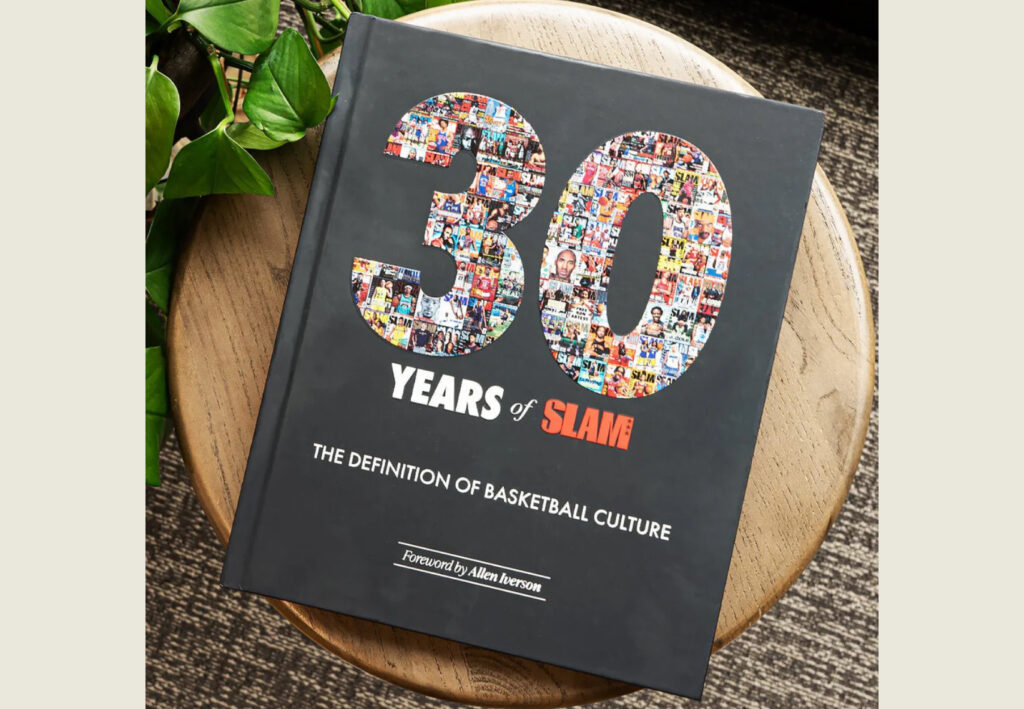For three decades, SLAM has been the pulsating heart of basketball culture—a print magazine, a cultural manifesto, and an aesthetic force wrapped into one. To celebrate its 30th anniversary, SLAM has distilled its legacy into a hardcover book of visual ferocity and lyrical devotion: SLAM: The Definition of Basketball Culture. This is more than a retrospective. It’s a testament to basketball’s evolution as art, rebellion, community, and style.
In an era where print struggles to survive, SLAM remains immortal—not because of nostalgia, but because of relevance. From the beginning, the magazine was never just about box scores or post-game quotes. It was about energy, language, posture. It chronicled Allen Iverson’s tattoos with the same reverence as Michael Jordan’s fadeaway. It knew that basketball wasn’t only played—it was performed, dressed, lived.
This new hardcover isn’t just a greatest-hits compilation; it’s a curated archive of an entire cultural moment, page after page. The book is broken into sections that echo the magazine’s most defining pillars: Iconic Covers, Game-Changers, Style & Sneaker Legacy, Streetball Legends, and The Language of the Game. Together, they form a time capsule that both celebrates and interrogates what it means to be of basketball.
From the first issue in 1994 featuring Larry Johnson in full “Grandmama” glory to its more recent profiles of Bronny James and Caitlin Clark, SLAM has always straddled the now and the next. The early pages of the book resurface unforgettable layouts—bold fonts, shadow-drenched portraits, graffiti-style pull quotes that turned interviews into sermons. These were more than magazine spreads—they were posters for bedroom walls, gospel for playground prophets.
And the covers—always the covers. SLAM’s covers defined careers and froze eras in time. Kobe Bryant mid-smirk in No. 32. LeBron James as a high school sophomore, already anointed. Dwyane Wade suited in noir black like a Bond villain. Allen Iverson in cornrows and ice, every photo daring America to look closer. SLAM didn’t just capture the athlete—it captured the myth.
What SLAM also did—what this book reiterates—is democratize greatness. Streetballers from Rucker Park got ink just like NBA stars. High school phenoms received reverent treatment. The game wasn’t about contracts; it was about culture. The legends didn’t need to wear rings—they needed to move people. This archival project honors that ethic, devoting whole spreads to playground kings and underdog poets who never made it to the league, but made it into the pages of SLAM, which for many, was validation enough.
Equally important is how SLAM shaped the conversation around basketball aesthetics. The book dedicates a rich section to sneaker culture, capturing the DNA of player-brand relationships—from the birth of Jordan Brand to the rise of signature lines like Kyrie, KD, and Giannis. The magazine didn’t just report on shoes; it mythologized them. Photos of broken-in Jordans on sun-bleached courts, close-ups of laced Foamposites in locker room light—each image was an act of cultural preservation.
Fashion, too, gets its due. Before the NBA tunnel became the league’s unofficial runway, SLAM was spotlighting basketball’s intersection with hip-hop, streetwear, and Black identity. The book reprints profiles where hoopers talked as much about music and jewelry as they did about assists and field-goal percentage. This was the voice of SLAM—authentic, slang-heavy, uncensored, and joyfully defiant of journalistic orthodoxy. It mirrored the players it covered: raw, radiant, real.
The language is another pillar entirely. SLAM’s prose—equal parts sportswriting, spoken-word, and cipher-slang—broke away from traditional coverage. It wasn’t about objectivity; it was about immersion. You didn’t read SLAM like a newspaper. You rode it like a track. This book retains that energy. Vintage essays are reproduced without edit, allowing Gen Z to experience the unfiltered flavor of late-‘90s and early-2000s basketball writing—sentences that bounce, dunk, flex, and stare you down.
There’s also deep reflection. The final chapters in the book focus on the impact of SLAM—not just on media, but on the players themselves. Testimonials from icons like Kevin Durant, Candace Parker, J. Cole, and LaMelo Ball read like love letters. They speak not just of being covered, but of being seen. SLAM was never paparazzi—it was family. It chronicled ascents, collapses, comebacks, and legacies with the gravity of a mixtape and the intensity of a playoff game.
This book lands at a unique moment in basketball culture. As the NBA becomes more international, as NIL deals reshape college hoops, and as social media offers players their own editorial channels, the relevance of traditional platforms is questioned. But SLAM proves its value by staying anchored in voice and vision. The magazine was always an originator—not a follower. And this hardcover is its monument.
It’s also a challenge. To younger readers and next-gen creators, the book issues a dare: document the game like it means something. Don’t flatten the drama into stats. Don’t let the culture be reduced to content. Write it like it matters. Shoot it like it’s alive.
SLAM: The Definition of Basketball Culture is not a eulogy or a mere commemoration. It’s a manifesto, a flex, a torch. For hoop heads, style savants, sneaker purists, and language lovers—it’s essential. It honors a legacy by refusing to let it settle. In these pages, 30 years of basketball pulse in ink and image, legacy and lingo.
It’s more than a book. It’s the court, the mic, the stage. It’s SLAM—still defining the game, still defining the culture.
No comments yet.







